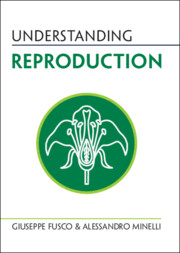Book contents
- Understanding Reproduction
- Series page
- Understanding Reproduction
- Copyright page
- Reviews
- Contents
- Foreword
- Preface
- Acknowledgements
- 1 Individuals and Reproduction
- 2 Reproduction in the Life Cycle
- 3 Reproduction Without Sex
- 4 Reproduction with Sex
- 5 Two-Parent Sexual Reproduction
- 6 One-Parent (or Nearly so) Sexual Reproduction
- 7 Development of Sexual Traits
- 8 Widening the View: Reproductive Strategies
- Concluding Remarks: Difficult Boundaries
- Summary of Common Misunderstandings
- References and Further Reading
- Figure Credits
- Index
5 - Two-Parent Sexual Reproduction
Published online by Cambridge University Press: 27 July 2023
- Understanding Reproduction
- Series page
- Understanding Reproduction
- Copyright page
- Reviews
- Contents
- Foreword
- Preface
- Acknowledgements
- 1 Individuals and Reproduction
- 2 Reproduction in the Life Cycle
- 3 Reproduction Without Sex
- 4 Reproduction with Sex
- 5 Two-Parent Sexual Reproduction
- 6 One-Parent (or Nearly so) Sexual Reproduction
- 7 Development of Sexual Traits
- 8 Widening the View: Reproductive Strategies
- Concluding Remarks: Difficult Boundaries
- Summary of Common Misunderstandings
- References and Further Reading
- Figure Credits
- Index
Summary
For most people, the most obvious thought or image that sexual reproduction brings to mind is that of sexual intercourse, a mating between two individuals of opposite sexes, which will result in the birth of their common offspring. While biparental reproduction is certainly the most common mode of sexual reproduction among all eukaryotes, it is not the only one, and the way it is carried out can depart substantially, in many different ways, from the ‘canonical’ description above. What is common to all these modes is that two distinct sexually compatible individuals (parents) undertake a sexual exchange that leads to the generation of new individuals with a genetic constitution obtained from the association and/or the reassortment of those parents’ genomes. The key event in this mode of reproduction, technically called amphigony, is the fusion of two gametes or two nuclei functioning as gametes (syngamy), each produced by one parent, to form a zygote. While in species with anisogamy (i.e. with distinct male and female gametes; Chapter 4), only gametes of opposite sex are compatible, the two individuals that produce them are not necessarily a male and a female.
Keywords
- Type
- Chapter
- Information
- Understanding Reproduction , pp. 88 - 107Publisher: Cambridge University PressPrint publication year: 2023



